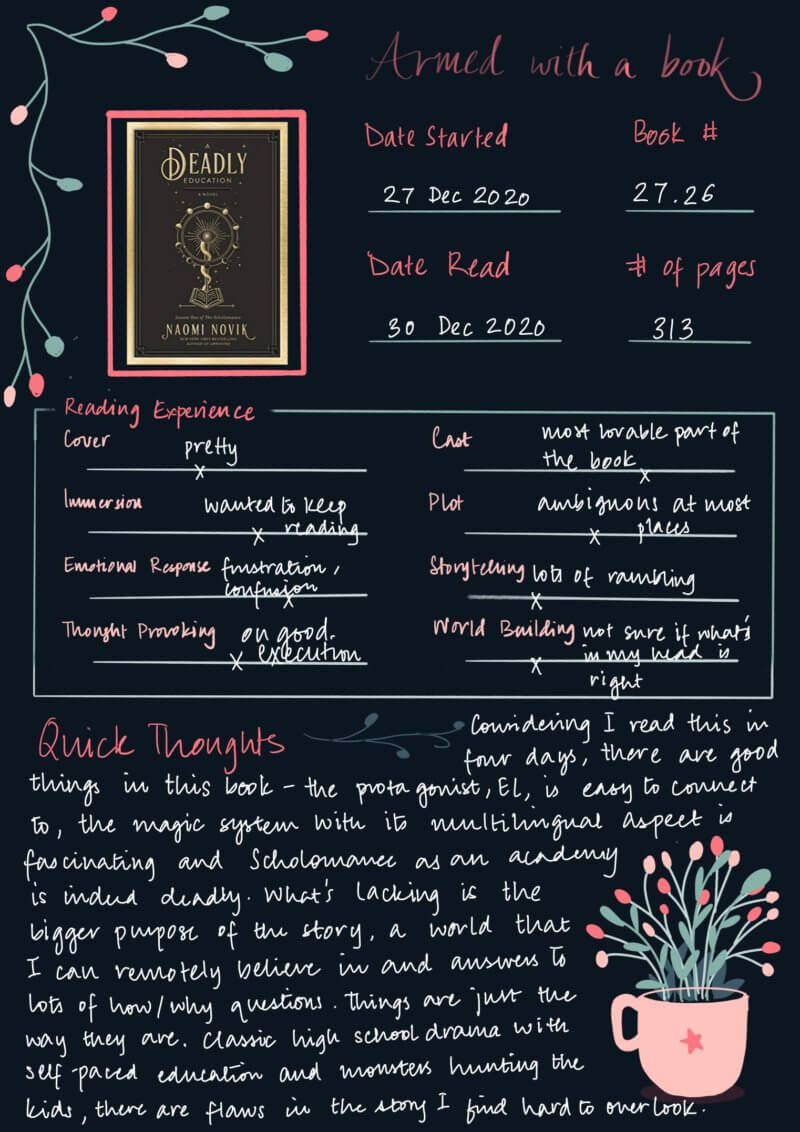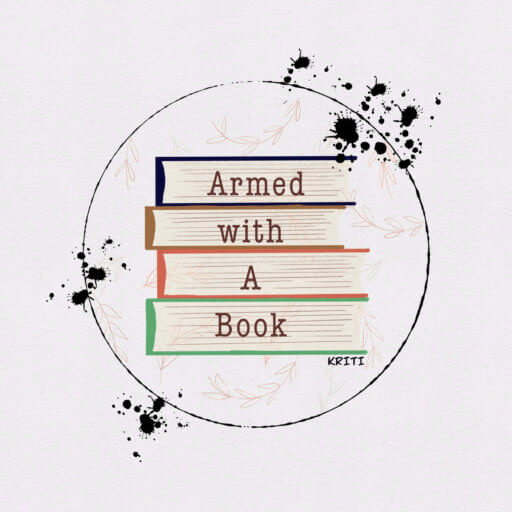A Deadly Education by Naomi Novik is the first book in The Scholomance universe and if you want to feel like you are back in school with cut throat politics and monsters, this is the book to pick up. This book made me think about all the boarding school books I have read and can remember – I can go way back to Enid Blyton’s books like 𝙎𝙩 𝘾𝙡𝙖𝙧𝙚’𝙨, 𝙏𝙝𝙚 𝙉𝙖𝙪𝙜𝙝𝙩𝙞𝙚𝙨𝙩 𝙂𝙞𝙧𝙡, 𝙖𝙣𝙙 𝙈𝙖𝙡𝙤𝙧𝙮 𝙏𝙤𝙬𝙚𝙧𝙨 (I so wanted to live in a boarding school when I was younger) and then 𝙃𝙖𝙧𝙧𝙮 𝙋𝙤𝙩𝙩𝙚𝙧 came along, opening up a world of Fantasy at boarding schools. Lev Grossman’s 𝙏𝙝𝙚 𝙈𝙖𝙜𝙞𝙘𝙞𝙖𝙣𝙨 𝙏𝙧𝙞𝙡𝙤𝙜𝙮 graduated magic and boarding schools to the university and showed other sides of magic. Take a look at the synopsis below and then dive into our discussion:

Lesson One of the Scholomance: Learning has never been this deadly.
A Deadly Education is set at Scholomance, a school for the magically gifted where failure means certain death (for real) — until one girl, El, begins to unlock its many secrets.
There are no teachers, no holidays, and no friendships, save strategic ones. Survival is more important than any letter grade, for the school won’t allow its students to leave until they graduate… or die! The rules are deceptively simple: Don’t walk the halls alone. And beware of the monsters who lurk everywhere.
El is uniquely prepared for the school’s dangers. She may be without allies, but she possesses a dark power strong enough to level mountains and wipe out millions. It would be easy enough for El to defeat the monsters that prowl the school. The problem? Her powerful dark magic might also kill all the other students.
Content Notes: Depictions of assault, attempted murder, death, poor living conditions and violence.
A Deadly Education
The Reading Discussion
This one was an impromptu buddy read for us – one of those books that we both had on our lists and could prioritize by reading together. What drew you to this book, Meisha?
Good question! I easily succumb to peer pressure and saw this book a lot on bookstagram, so then I wanted to read it too, of course. That it was about a school that wanted to kill the students sealed the deal for me!
Haha I am the same. See a book too many times, remotely admire the cover and then read it. And yes, this was such a deadly school! I was not expecting for there to be no adults whatsoever in the scenario. I am a little bit unsure about the age at which one is inducted into Scholomance and then length of the education itself. What did you gather about this from the book?
It seemed like just a high school, so ninth grade to twelfth grade. I’m not positive on the time length. My assumption is one year, but I think I remember the main character, El, saying something like nine months, which would be a normal school year if you ignore summers. It’s hard for me to believe that poor little ninth graders would fare better in a deadly school like this one than in their homes, but that did seem to be the situation.
My friend who is on top of book critiques told me that one of the concerns about this book that some reviewers had was the portrayal of Indian culture. Since I am originally from India, she was interested to know my take on it. I don’t think that the book truly infused any one culture into the story – the author used languages to show diversity and that wasn’t something that I had expected. There were a couple of roots in Hindu mythology (which I totally fact checked) but there was this one point in the story when El was talking about the rare book that she found and the confusion around translations – the original work was in Sanskrit but the book was in Arabic and I got this vague feeling like Sanskrit and Arabic were being linked in origins. This reminds me of the many convoluted plot points throughout this book where languages and people were too many and too varied.
I definitely don’t see this book as a good example of dealing with various cultures. Nor would I necessarily expect it to be, especially coming from a white author who doesn’t have firsthand knowledge. I’ve seen some critiques where people say this book is a big letdown if you’re looking for a nuanced approach to different cultures, and I would definitely agree with that. I think it does a much better job of digging into privilege and different classes of wealth than it talks about anything to do with culture.
I really like your point about how it shows privilege, especially through characters like Orion who is super powerful and just always there to help people out but so oblivious to the consequences. The whole concept of magical enclaves, how and why they exist speaks to different classes within the wizard world. The Scholomance itself being open to non-enclave kids as fodder to the monsters was brutal and another pointer to how the wizards think and will use kids to strengthen their own enclaves.
Yes! This theme was one of my favorite things about the book.
You and I also chatted about the characters and how we imagine them in our head during one of our conversations and that also speaks to how much we had to rely on our own imagination than the book itself. There are some beautiful sketches of the Scholomance and the student rooms in the book but I honestly needed pictures for the monsters which were a huge part of the narrative. I imagined the ones with ‘spider’ in their name to look like grand spiders but no idea what maw-mouths look like.
I don’t recall what most of the monsters look like (or even the different names). There were so many monsters but not enough description to really tell them apart or remember them well. I was kind of frustrated that it took us until nearly the end of the book to actually get a description of what El wears on a daily basis. I did not have a vivid picture of what the school, the characters, or the monsters are supposed to look like.
Their living conditions are horrendous. I do not know how they are surviving with bare minimum food and such terrible hygiene. Who in their right minds would let their kids through this?
I was wondering the same thing… It was only towards the end when El said that the enclave kids had an 80% chance of survival in the school than the 40% chance they did in the enclave where I was finally like, okay, I guess that makes sense. I have to assume that the survival rate for non-enclave kids is even lower than 40% without all those other enclave wizards around.
I suspect so. I am curious about the rest of the world and how they are doing for their kids. Scholomance felt like a mix of magic and technology, which was kind of cool, to be honest. As a trained teacher, I am fascinated by the work ethics of the kids and how the school got them to learn on their own. It was just really nice to be in school (minus the trying-to-kill-every-student part).
How the school runs, in general, is something that still doesn’t make much sense to me. Though I did also think it was interesting seeing how self-motivated the students have to be. Of course, their survival does depend on it! But I think it’s strange that the school has a way of making you regret not doing homework, yet doesn’t care if you cheat on your assignments… It was just a weird mix of rules which I didn’t think were explained very well.
Yes, I won’t say that based on the “teaching” practices, the assessment was any good. Like you said, lots of rules, a good chunk of with no explanation why and how.
There were quite a few times where El just said, “Why does it work that way? No one really knows…” I get that the story was close 1st-person narration, but those parts had me rolling my eyes.
I did really enjoy El, overall, however. I could have done without the rambling, heavy inner monologue she had throughout the novel, but I loved her snarkiness and her unique combo of being abrasive and stand-offish yet also wanting to be loved and accepted.
She is the reason why I kept reading this book. So many stories are either about the popular kids or the quiet kids. Very few stories go into the struggles of the hated kid. When El finally got the courage to ask Aadhya why she doesn’t have friends (which was heartbreaking and very brave of her to ask), Aadhya’s response on how she feels like it’s about to rain made me think about the vibes that certain people have. I loved that throughout the book as El developed, she made friends and tried to understand what friendship and alliances mean. I like that she reassessed her goals to get into an enclave and why she wanted it. What did you think of the rest of the cast?
What we got of everyone else, I did enjoy. Since El is a loner in the beginning, we didn’t get much of everyone else until further along in the book. Getting to know the side characters better is a big part of why I still want to read the second book. I want more! I especially liked Orion, even if he was a bumbling, oblivious hero! His dynamic with El was a highlight of the novel.
Yes, he made the story more fun by being himself and through him we got to learn more about the enclaves and expand the world more.
I am looking forward to reading the second book as well. It will be their final year and now that we know the world and politics a little bit better, other aspects of the story can be expanded more.
I’m betting that the second book will be a much smoother, more entertaining read without so much of the introductory world-building, so I’m cautiously optimistic to see what happens next.
The Last Graduate is expected to release on July 6th 2021.
While A Deadly Education was a fast-paced read, I think of it like candy – it is bad in huge quantities but one of those things that you just can’t get enough of. So if you are looking for some candy to enjoy, check out this book. Once you get used to the rambling, you’ll be able to finish it in no time. It is hard to put down and one you will think about long after you are finished. You’ll be on a ride to learn more. 🙂

** A Deadly Education is available in stores. I am sure you will be able to find them at your local library too.**
Cover Photo by Aditya Vyas on Unsplash

Be First to Comment